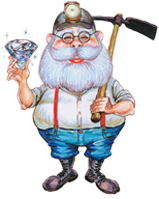Faceting
All of the following information has been graciously provided by Daniel and Cynthia Stair of CustomGemstones.com. The following information and photos are from his website. For more information on his company, please check out our links page under domestic faceting services.
1) Good Stone vs. Bad Stone, Why custom cutting makes a difference!
2) Faceting, How a Gemstone is cut.
THE GOOD vs. THE BAD AND THE UGLY
The photos below are a comparison of a "commercial cut" stone on the left vs. one of my custom cut stones on the right. Note that I treated both stones equally when photographing them. Neither has been "touched up" and both were wiped off with alcohol prior to my taking the picture. Also, for comparison sake, I did the best I could to cut a 6mm x 8mm rhodolite garnet of comparable color to the native stone. The one thing that is unfair is that the native cut stone is a bit more included. It now resides in my fish tank. :-)
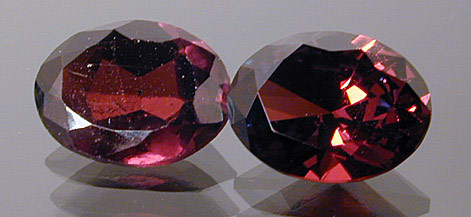
OPTICAL PERFORMANCE - In this photo, notice that there is light reflecting and sparkling in the stone on the right, and a large lighter colored area in the middle of the stone on the left. The native cut stone was cut at the wrong angles and light will just pass through this area which is often referred to as a "window" or a "fish eye" and the stone will appear dead inside. The stone on the right sparkles because the light can't escape through the bottom of the stone. It bounces around inside, and then back up through the top, often in different colors due to the phenomenon of "refraction" (notice the little blue spots).
POLISH - Look at the polish on the surfaces of the stones. The one on the right is highly polished. This greatly benefits the brilliance of the stone. The stone on the left was probably never polished well, and then it was most likely thrown in a bucket or bag with other garnets of the same hardness, and microscopically scratched and pitted as the stones were repeatedly handled. Even if this stone were "flawless", it would look included or dirty upon close inspection. Another thing to watch for when looking at the polish of a stone are "striations" or parallel lines/streaks that are actually gouges in the surface of the stone.
"MEETS" - Both the photo above and the one below demonstrate bad meet points where facets should touch each other but don't. Look at the closer edge of the table on the native stone and you'll see a facet, a line, then a facet. Those facets should touch each other.
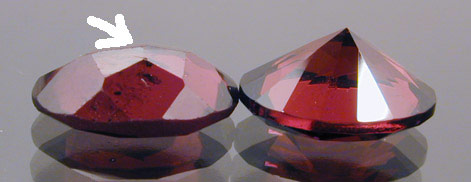
CUTTING FOR WEIGHT??? - The stone on the left, oddly enough, was actually cut for weight and the stone on the right was not. The white arrow points to the culet (the point on the bottom of the stone), which was cut on too shallow of an angle, creating the "window" that you can see in the top photo. This stone should have been cut smaller so that the proper optical angle could have been achieved. The other way to cut a stone for weight is to have the entire bottom (pavillion) of the stone "belly cut", the extreme opposite of the native stone I'm showing here. What's really sad is that often native cutters will cut a really deep stone, then make that last set of crucial culet facets too shallow and still cut a window, even though there was plenty of material to work with. Also, they'll cut the crown (top of the stone) super shallow so that they can make a bigger belly in the pavillion, and consequently a heavier stone.
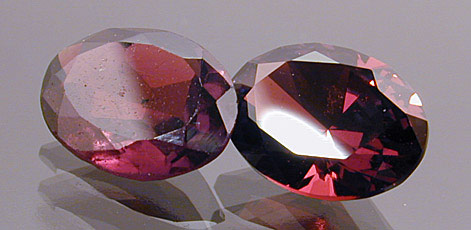
This last photo is just another demonstration of good polishing vs. bad polishing. What's that saying? A picture is worth a thousand words!
About all a person can say about the native cut stone is "Yep, it's a 6mm x 8mm faceted rhodolite garnet oval"
They're all the same right????
(copyright (c) 2000, Daniel J. Stair, Jr., all rights reserved)
How A Gemstone Is Cut
IS THAT AMAZING OR WHAT? copyright (c) 2000 - 2009, Daniel and Cynthia Stair, all rights reserved 
The photo above is of a Songea sapphire I'll be cutting on this page. As you can see, this stone is not quite round, so we'll fix that by preforming it a bit.

Here's a photo of my Facetron faceting machine. Not too hi-tech, but very precise. 
Here's a close-up of the sapphire sitting on the diamond impregnated steel lap (or disc). You can see the diamond crystals sparkling. Since diamond is the only natural substance harder than that sapphire, diamond is what it must be cut with. 
With the lap spinning, and water dripping on it that serves as a coolant and lubricant, I am preforming the stone by hand, and basically just rounding it off and grinding a flat spot on top of it. 
Here I'm using a fiber optic light to show that I've got it pretty round, and you can see the flat spot in the middle that will eventually be the table of the stone. 
Next, I'm heating up the "dop" which is a brass stick that I'll attach the stone to using a special wax. This stick, will then be plugged into the arm of the faceting machine. 
Here I have the stone stuck to the dop, and before the wax cools to become hard, I have placed it into the transfer jig, and used a cone dop pressed down on it to center it perfectly. 
Here's a close-up of the stone on the end of the dop. 
Here's a front view of the faceting head of the machine. You can see where the dop plugs into the end of the arm in the lower part of the photo. The arm raises and lowers in degrees, and rotates in equal increments. In other words, if it has a 96 index gear on the top end, it rotates in a circle divisible by 96 equal segments. Also, the entire head slides up and down the stainless steel mast and can be locked in to place at any position. 
Looking more downward on the faceting head, you can see the black, replaceable index gear, and see that the entire arm, gear, etc. pivot on a big hinge of sorts. To the left is the square cutting depth indicator and once I've completed the first in a series of facets, or flat spots, a needle will rise up and show me when I've cut all the following facets to the same exact depth as the first one. 
From this view, you can see the crank at right that raises and lowers the arm in degrees. Notice the little black gauge next to it that tells what angle the machine is set at. In this case, 45 degrees. Also, the white nob is the locking mechanism that clamps the head down at a certain height on the stainless steel mast. 
Okay, here we go. In this photo I've inserted the dop into the end of the arm, and have locked it in place with the "key" in the upper right. Now we're ready to start cutting. 
First, I'm going to set the arm at 90 degrees and cut a series of flat spots around the edge, or girdle, of the stone and make it perfectly round. 
Here's a zoomed in look at cutting the girdle. I lower the arm down onto the spinning lap, make a little flat spot, rotate the arm a small amount and repeat, all the way around the stone. 
Here's what it looks like after being rounded off. Notice all the little flat spots. Later, I'll smooth those off on an ultra-fine diamond lap. 
Next, it's time to raise the faceting head up the mast, change the angle and begin cutting the facets that will form the point at the bottom of the stone. This point is called the "culet" of the stone. In the upper left corner of the photo, you'll notice the water dripping from a white tube. Again, this is the coolant and lubricant that keeps the stone from heating up, melting the wax, and falling off the dop. The stainless steel lap is now spinning fairly fast. 
Now, I've gone all the way around the stone, and cut 16 rough facets that will allow me to establish the depth of the "pavillion" which is the bottom of the stone. Next, I'll change to a finer grit diamond lap, and begin the final cutting of smaller facets that will be all ready for polishing. 
Here you can see the design I've chosen, or made up in this case. It's a Portuguese style pattern that has twice as many facets as a standard round brilliant. Next, the time consuming process of polishing an extremely hard sapphire. 
Here I'm using a fine diamond paste on an aluminum lap. The aluminum transfers the heat out of the sapphire a lot better than other polishing laps, and lets me polish harder without melting the wax that holds the stone on the dop. It can be a real nightmare when the stone shifts or fall off. 
Here you can see that I've polished some of the facets. Not the greatest photo, but you get the idea. 
In this photo, I've polished the entire pavilion and it's ready to be transferred to a cone dop, so that I can cut the "crown" or top of the stone. 
This is the transfer jig. At the top of the photo, is the dop with the stone still attached. At the bottom of the photo is the cone dop, that I've covered in hot wax and made an impression in by sliding the two together, then pulling them apart. Next, I'll put one drop of crazy glue into the wax impression in the dop at the bottom of the photo, and slide the jig to put the two together. 
The jig was sitting up on end, but is now sitting down flat which I did after sticking the new dop to the stone using the crazy glue. The dop on the left is the one receiving the stone, and it is in a metal clamp device that slides on the two black rails at the bottom of the photo. The clamp on the right is fixed on the rails. Thumbscrews tighten the clamps down to hold the dops in place. After the glue has dried, I'll remove both dops from the jig, and melt the original one off using the alcohol lamp. 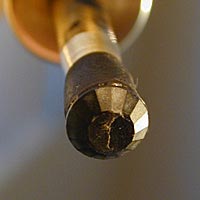
Next, I'll plug the dop with the stone on it back into the machine and start cutting the facets of the crown. Notice you can still see a little wax in the middle of the stone from where the original dop was stuck onto it. 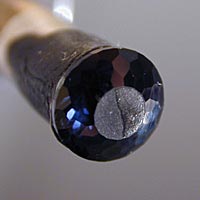
Now, I've cut and polished all three rows of 16 facets that make up the crown of the stone. LOOK! It's starting to tease us a little with some blue sparkles. This is where it starts to get kind of exciting, because the first signs of what it will look like are starting to show. You can see that now I need to cut the "table", or flat spot on the top of the stone. 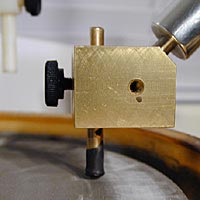
Cutting and polishing the table requires the use of this adapter that is plugged into the arm of the machine. 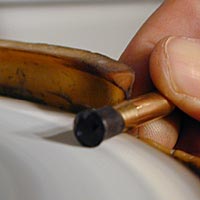
After the table is cut and polished, which can take awhile with a bigger sapphire like this, the last step is to polish the "girdle" or edge of the stone. A lot of cutters don't like to hassle with it, but I always polish it because it would look ugly and be quite obvious especially in a prong-type mounting. 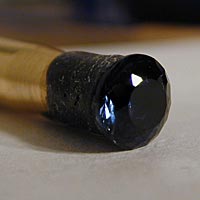
HOORAY!!!! It's done! But wait, it still doesn't look like much. Here's a good lesson on why you should keep your stones clean. Having the pavilion all gooped up kills the brilliance. In this case it's because of crazy glue and wax, but hand lotion can really do a number too. Now for the best part of the whole process. It's hard to tell what it really looks like until you remove it from the dop and clean the goop off it. Hmmm. It looks a little different than it did at the top of the page! 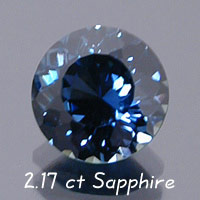
All graphics, images, text and overall layout design on this website are property of Daniel and Cynthia Stair and may not be downloaded or reproduced in any way without express written permission or unless otherwise noted.

